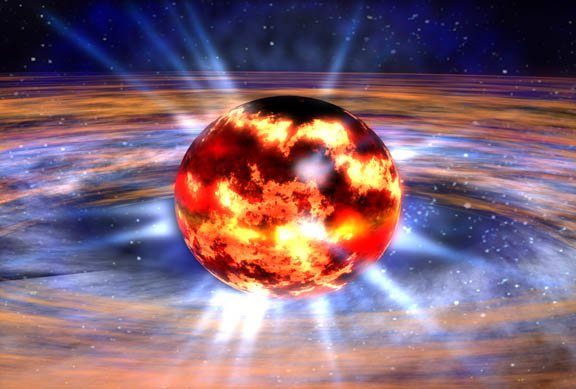Tiny Blackholes Coming into Contact with Neutron Stars Could Have Helped Forge Heavy Elements
Astronomers usually say we are the byproducts of stars, massive furnaces that long ago, through the process of stellar nucleosynthesis, fused hydrogen and helium into the elements that are needed for life.
As the famous astronomer Carl Sagan once said: “The nitrogen in our DNA, the calcium in our teeth, the iron in our blood, and the carbon in our apple pies were made inside the collapsing stars. We are built from star stuff.”
However, what could be said about the heavier elements in the periodic table, elements like gold, platinum and uranium?
These elements, which are much heavier than iron, are called “R-process elements.” Astronomers think that most of these elements were created either after the collapse of huge stars and the associated supernova explosions or in the merging of binary systems of neutron stars.
George Fuller, a theoretical astrophysicist and director of the UC San Diego’s Center for Astrophysics and Space Sciences, explains that a different kind of furnace was needed in order to forge gold, platinum, uranium and most other elements heavier than iron. These elements most likely were built in an environment rich with neutrons.
He and two other theoretical astrophysicists at UCLA offer another means by which stars could have produced these heavy elements: tiny blackholes that came into contact with and are captured by neutron stars, and then destroy them.
Neutron stars are the smallest stars known. In fact, they are so dense that just a spoonful of their surface material has an equivalent mass of three billion tons.
Many astronomers believe that tiny blackholes are a byproduct of the Big Bang and that they could now make up a part of the “dark matter”—the unseen, nearly non-interacting stuff that, according to observations, exists in the universe.
Fuller and his colleagues calculate that, in rare instances, a neutron star may capture such a blackhole and then be devoured from the inside out by it. This is a violent process that can lead to the ejection of some of the dense neutron star matter into space.
Fuller explains that small blackholes that are produced in the Big Bang can invade a neutron star and eat it from the inside. The amount of neutron-rich material ejected in the last moments of the neutron star’s demise is sufficient to explain the observed abundances of heavy elements.
He added that as the neutron stars are devoured, they eject cold neutron matter, which then decompresses, heats up and makes these elements.
Source: Science Daily

Nice post about science..like it
Good stuff. Keep it coming fam
Always science gives us something which is unbelievable like "We are built from star stuff", but how about all the people will have the same composition (nothing more nothing less).